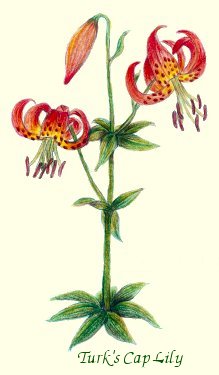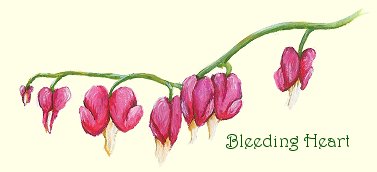


Here is another of of the wildly varied types of botanicals found in the immediate vicinity of where I live in western North Carolina in the United States. I plan to add more in the future. So please come back some time.

The Turk's-cap Lily (Lilium superbum) is the most spectacular flower that I have come upon in the woods. Between 2 and 8 feet tall, and from 3 to 5 inches wide, it is the largest lily of the native species found in this country. Up to 40 flowers have been recorded on a single plant. The Turk's-cap Lily is in bloom from July to September and is found in wet meadows, swamps, and woods. The recurved sepals and petals resemble a type of cap worn by early Turks, hence the name. This lily is very similar to the Tiger Lily, but the Turk's-cap Lily lacks the scattered leaf pattern and lacks the blue-black bulbils that are clustered at the leaf bases of the Tiger Lily. It also lacks the wonderful legend of how the Tiger Lily got its name. It is said that a hermit once befriended a tiger by removing an arrow from its leg. Years later, when the tiger died, its body was transformed into a lily; and after the hermit himself died, the Tiger Lily spread across the land in search of its friend. Thanks to gardeners, its search is now worldwide. I thought that was a neat legend and just had to include it, even though it is about the Tiger Lily, not the Turk's-cap Lily.
 Okay, the Ginkgo (Ginkgo biloba) isn't native to the area, but it is a fascinating tree! This tree is unique in all the world and deserves a mention in any work on botanicals. Every living thing is unique enough to have its own species and genus, but the Ginkgo is the only living thing to have its own species, genus, family, and order! It has been on this planet before the first dinosaur was hatched, it has been around before the Alps and the Himalayan Mountains were formed, and it has been around for about 250 million years. It was here when this planet only had ferns, and its leaves are simliar to ferns in that they have no bisecting rib in them. It evolved long before leaf-eating insects, so that insects do not eat them. It used to have more members in its family, about 18, but died down to 1 about 65 million years ago. Maybe it had to do with the dinosaur die-off, maybe the dinosaurs were seed dispersers. It died off the North American continent about 7 million years ago, and it actually was thought to be extinct until 1691 when it was discovered in Japan. It also had been found in monestaries and palaces of Buddhist monks in China. Though they live 1,000 years or more, it takes the right climate to grow slow enough to survive 1,000 years. Most Ginkgos that you see will be in the environment that makes it grow faster, but die sooner. Most will be male trees, since the female trees have a fleshy, plumlike fruit that will fall from the trees and has a unpleasant rotting smell.
Okay, the Ginkgo (Ginkgo biloba) isn't native to the area, but it is a fascinating tree! This tree is unique in all the world and deserves a mention in any work on botanicals. Every living thing is unique enough to have its own species and genus, but the Ginkgo is the only living thing to have its own species, genus, family, and order! It has been on this planet before the first dinosaur was hatched, it has been around before the Alps and the Himalayan Mountains were formed, and it has been around for about 250 million years. It was here when this planet only had ferns, and its leaves are simliar to ferns in that they have no bisecting rib in them. It evolved long before leaf-eating insects, so that insects do not eat them. It used to have more members in its family, about 18, but died down to 1 about 65 million years ago. Maybe it had to do with the dinosaur die-off, maybe the dinosaurs were seed dispersers. It died off the North American continent about 7 million years ago, and it actually was thought to be extinct until 1691 when it was discovered in Japan. It also had been found in monestaries and palaces of Buddhist monks in China. Though they live 1,000 years or more, it takes the right climate to grow slow enough to survive 1,000 years. Most Ginkgos that you see will be in the environment that makes it grow faster, but die sooner. Most will be male trees, since the female trees have a fleshy, plumlike fruit that will fall from the trees and has a unpleasant rotting smell.
 The eastern Wild Bleeding Heart's (Dicentra eximia) name is inspired by their flower shape, the heart. Though they are in the Poppy family, they are closest related to the Dutchman's Breeches and Squirrel Corn, also inspiring names. Bleeding Hearts bloom in small groups from April to June on rocky wooded areas and ledges, but also along stream beds in the Smokey Mountains Park. The blooms are strung along a leafless stem, but the plant does have leaves. Bleeding Hearts are pollinated by bees, butterflies, and hummingbirds. While I haven't seen it growing in the wild, I have seen it growing in the gardens at the NC Arboretum.
The eastern Wild Bleeding Heart's (Dicentra eximia) name is inspired by their flower shape, the heart. Though they are in the Poppy family, they are closest related to the Dutchman's Breeches and Squirrel Corn, also inspiring names. Bleeding Hearts bloom in small groups from April to June on rocky wooded areas and ledges, but also along stream beds in the Smokey Mountains Park. The blooms are strung along a leafless stem, but the plant does have leaves. Bleeding Hearts are pollinated by bees, butterflies, and hummingbirds. While I haven't seen it growing in the wild, I have seen it growing in the gardens at the NC Arboretum.
 The Jerusalem Artichoke (Helianthus tuberosus) is a member of the Sunflower family. It can grow fairly tall from 3 to 10 feet with the flowers being 2 to 4 inches. The leaves are 4 to 10 inches long. The stalk divides into 3 stalks with the leaves being opposite below and alternate on the above stalks. It blooms from August to October. Like all sunflowers, they face the sun. And since light inhibits the growth of the stem; the shaded side of the stem grows fastest tipping the flowerhead toward the sun. The Jerusalem Artichoke's name is a corruption of the Italian word girasole which means "turns to the sun". It is a flower that is cultivated for its edible tubers (the so called artichokes). It was cultivated by the Indians and has spread eastward. It was even feed to Lewis and Clark by the Indians on their trip through North Dakota. The tuber is highly nutritious and contains no starches, but is a carbohydrate in a form that metabolizes into a natural sugar. They can be boiled or roasted like a potato or served raw where it has a sweet, nut-like taste.
The Jerusalem Artichoke (Helianthus tuberosus) is a member of the Sunflower family. It can grow fairly tall from 3 to 10 feet with the flowers being 2 to 4 inches. The leaves are 4 to 10 inches long. The stalk divides into 3 stalks with the leaves being opposite below and alternate on the above stalks. It blooms from August to October. Like all sunflowers, they face the sun. And since light inhibits the growth of the stem; the shaded side of the stem grows fastest tipping the flowerhead toward the sun. The Jerusalem Artichoke's name is a corruption of the Italian word girasole which means "turns to the sun". It is a flower that is cultivated for its edible tubers (the so called artichokes). It was cultivated by the Indians and has spread eastward. It was even feed to Lewis and Clark by the Indians on their trip through North Dakota. The tuber is highly nutritious and contains no starches, but is a carbohydrate in a form that metabolizes into a natural sugar. They can be boiled or roasted like a potato or served raw where it has a sweet, nut-like taste.
The best quote that sums up the whole journey of hunting, finding, and cataloging botanicals is from Barbara Kingsolver's "Prodigal Summer"
"...But solitude is only a human presumption. Every quiet step is thunder to beetle life underfoot; every choice is a world made new for the chosen. All secrets are witnessed."
So take a walk, see what you can find, but be aware that every step changes the world where you have been.

References
- "Field Guide to North American Wildflowers" Eastern Region published by the National Audubon Society
- "North American Wildlife" published by Reader's Digest
- "Eastern Forests" published by the National Audubon Society
- "Medicinal Plants and Herbs" Eastern/Central by Steven Foster and James A. Duke (Peterson Field Guide)
- "Wildflowers of the Smokies" published by Great Smoky Mountains Association




Home
Site Map
Email at: dh @ naturehaven.com
(Take out the spaces and this email address will work!)
Please Read Guestbook ~~~ Please Sign Guestbook


